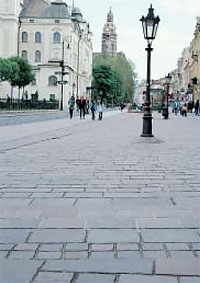|
|
 |
 |
 |
    |
 |
You can reach us by
e-mail, phone or regular
mail. We look forward
to hearing from you.
818-402-0711 more
|
|
 |
|
|
|
|
|
|
 |
 |
 |
   |
 |
|
|
 |
 |
Fig. 23 -Slab paving in natural
cleft, split edge tiles in
Kosice, Slovakia.
|
Slab paving
We refer to slab paving when when the elements can be defined as "two-dimen-sional", i.e. with a thickness far inferior than their width and length. The porphyry elements used today for slab pavements have a thickness ranging from 2 to 8 cm and surface length and width varying between 10 to 50 cm. Two types of slab elements exist on the market: tile and flagstone.
Flagstone is obtained directly at the quarry by sorting the stratified slabs after extraction. The slabs are more or less irregular polygon-shaped with rough split edges and natural cleft surfaces and are sorted by size and thickness, which can vary from 2 to 7 cm. Flagstone is used mainly for external pavings (sidewalks, courtyards, promenades, gardens, etc.)and sometimes for cladding (retaining walls, buildings, terraces, etc.).
Tiles are rectangular elements produced from irregular slabs with natural cleft faces and variable thickness (Fig. 23).
Various types of tiles may be obtained through different processing techniques: natural cleft tiles with split edges and natural cleft tiles with sawn edges. Split edge tiles are produced with hydraulic presses which hold and snap the irregular slabs, resulting in rough, slightly chamfered corners. Natural cleft tiles with sawn, squared edges are produced on a circular disk saw. Special tiles in Stardust porphyry, obtained from from blocks sawn on gang saws or block saws, have a gauged thickness.
|
 |
|
|
 |